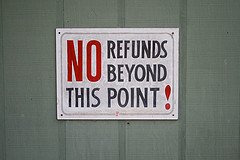Let’s Revise! – 21 Online Payment Definitions You Should Know
From the outside it may seem that online payments are easy. You just need to attach your webpage to a paying agent of your choice and swoosh, ready to go. The money just starts flowing.
From the outside it may seem that online payments are easy. You just need to attach your webpage to a paying agent of your choice and swoosh, ready to go. The money just starts flowing.
Yeah, that’s possible. And in fact not so rare. The same card, similar transaction. We are able to pay for one product (on website #1), but we aren’t for another one (on website #2).
 There are two things that e-business owners hate, one -abandoned shopping cards and two – people not returning to their business (granted, the two do correlate). Now there may be various factors going exactly into why this is happening, but there is one factor that could be solved with ease: the shopping process. There are various online stores that bombard their potential customers with long check out forms, multistage shopping carts, and incredibly hard to understand commands. It’s more than tiresome when you’re trying to just buy one product and you have to go through what seems like 100 light years worth of pages and boxes to fill out. The more you think about it, the more you realize you’d rather be looking for a different website with what you need than checking out here. This is why one-click payments were created! To make shopping less annoying and more conversion oriented.
There are two things that e-business owners hate, one -abandoned shopping cards and two – people not returning to their business (granted, the two do correlate). Now there may be various factors going exactly into why this is happening, but there is one factor that could be solved with ease: the shopping process. There are various online stores that bombard their potential customers with long check out forms, multistage shopping carts, and incredibly hard to understand commands. It’s more than tiresome when you’re trying to just buy one product and you have to go through what seems like 100 light years worth of pages and boxes to fill out. The more you think about it, the more you realize you’d rather be looking for a different website with what you need than checking out here. This is why one-click payments were created! To make shopping less annoying and more conversion oriented.
 Setting up a merchant account is above all about business possibilities. If you’re serious about your ventures, you can’t run an online shop nor accept card payments on your website without having it. Don’t cut corners, do it right!
Setting up a merchant account is above all about business possibilities. If you’re serious about your ventures, you can’t run an online shop nor accept card payments on your website without having it. Don’t cut corners, do it right!
It’s a separate bank account or rather a line of credit to a merchant that allows business to accept online payments, meaning money from online transactions. This account is established under an agreement between a merchant and an acquiring bank for settlement of all transactions processed on your website.
 I keep hearing the same questions over and over again and it doesn’t look like coming to an end… What the hell is a PayLane account? What’s the difference between a PayLane account and a merchant account? How many accounts do I need to have? And so on…
I keep hearing the same questions over and over again and it doesn’t look like coming to an end… What the hell is a PayLane account? What’s the difference between a PayLane account and a merchant account? How many accounts do I need to have? And so on…
So let’s make it clear once and for all. Quick and short. Here’s what it’s all about.
 When applying for a merchant account, you’ll be asked to fill out a merchant application. The application is typically standard across most merchant service providers with regard to the information collected on the application.
When applying for a merchant account, you’ll be asked to fill out a merchant application. The application is typically standard across most merchant service providers with regard to the information collected on the application.
In addition to the application, you’ll be required to provide support materials as they relate to the business and owners. Required merchant account support documents are as follows:
 Acquirer (also known as an acquiring bank or merchant bank). A financial institution and a member of a card association licensed with credit card companies. Best known card associations are Visa, MasterCard, American Express, JCB, Diners Club, China UnionPay.
Acquirer (also known as an acquiring bank or merchant bank). A financial institution and a member of a card association licensed with credit card companies. Best known card associations are Visa, MasterCard, American Express, JCB, Diners Club, China UnionPay.
Acquirer is a bank that accepts or acquires performed transactions with a use of credit and debit cards issued by all banks within the card association scheme.
 Refund – it’s the money (or its transfer) which a customer receives from a merchant after making a complaint. The whole process usually looks like this:
Refund – it’s the money (or its transfer) which a customer receives from a merchant after making a complaint. The whole process usually looks like this: